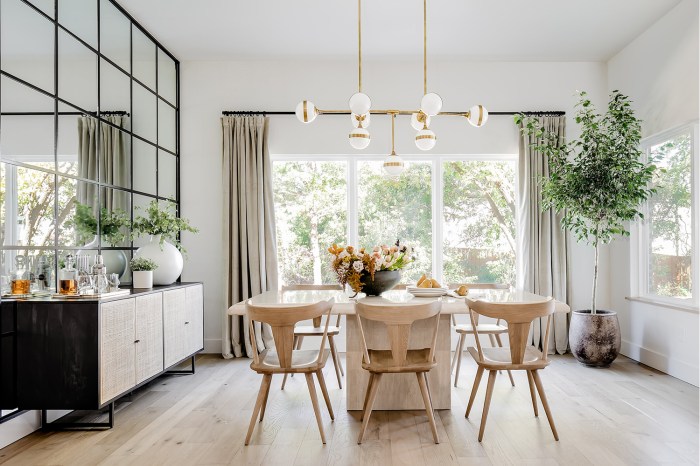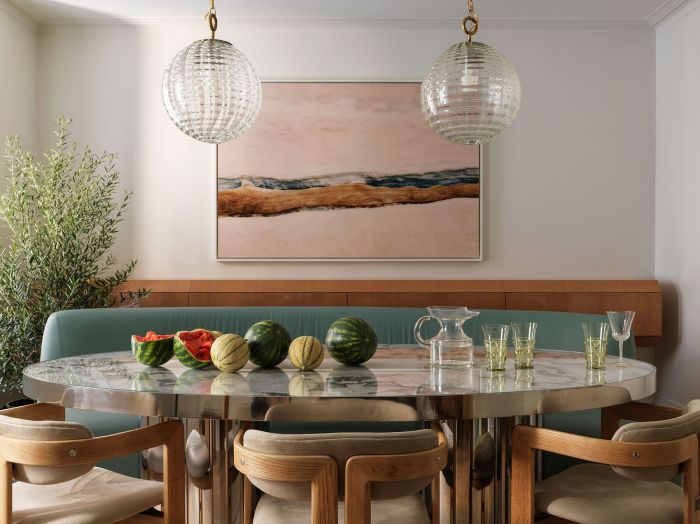Decor Styles and Wooden Dining Tables

Wooden dining table decor – The choice of a wooden dining table significantly impacts the overall aesthetic of a dining room, acting as a central design element. The style of the table, its wood type, and finish must harmonize with the chosen decor style to create a cohesive and visually appealing space. A mismatch can lead to a disjointed and ultimately unsatisfactory design.The inherent versatility of wood allows it to adapt to various decor styles, but careful consideration is crucial for achieving a successful outcome.
Different styles dictate specific design choices, influencing everything from the table’s shape and size to the accompanying accessories.
Rustic, Modern, Farmhouse, and Minimalist Styles and Their Influence on Wooden Dining Table Selection
Rustic styles favor heavily textured, reclaimed wood tables, often with visible knots and imperfections. These tables typically have a distressed finish or a natural, unpolished look. Modern styles, conversely, often opt for clean lines, sleek finishes, and perhaps even a minimalist approach to wood grain. Farmhouse style leans towards a more casual and comfortable aesthetic, using tables with simpler designs but often featuring painted finishes or subtle distressing.
Minimalist designs utilize simple, unadorned wooden tables, usually in light-colored woods with clean, straight lines, emphasizing functionality over ornamentation. The selection of the wood itself—oak, pine, walnut—also contributes to the overall style, each possessing unique visual characteristics.
Color and Texture Coordination in Dining Table Design
Color plays a vital role in coordinating the dining table with the room’s decor. A dark wood table, such as a walnut or ebony table, can create a dramatic focal point in a room with lighter walls and furnishings. Conversely, a light-colored wood table, like a bleached oak or maple table, can provide a sense of airiness and openness in a smaller space.
The texture of the wood itself, whether smooth or rough, also interacts with the overall texture of the room. A smooth, polished table might complement a modern, minimalist space, while a rustic table with a rough, hewn texture would be more suitable for a farmhouse or traditional setting. The color and texture of the chairs, rugs, and other furniture should also be considered to create a unified and harmonious design.
Complementary Materials and Finishes for Enhancing Wooden Dining Tables
The visual appeal of a wooden dining table can be significantly enhanced through the strategic use of complementary materials and finishes.
- Metal: Metal accents, such as iron or stainless steel legs, can add a touch of industrial chic to a rustic or modern table. Black metal legs, for instance, create a striking contrast against a light wood tabletop.
- Glass: A glass tabletop can create a modern and elegant look when paired with a wooden base, offering a visually interesting contrast of textures and materials. This combination allows the beauty of the wood to be showcased while adding a touch of sophistication.
- Stone: Incorporating stone elements, such as a stone base or a stone inlay in the tabletop, can add a touch of luxury and sophistication to the design. Marble or granite bases, for example, offer a striking contrast to the warmth of wood.
Centerpiece and Table Setting Ideas

The centerpiece and table setting significantly impact the overall dining experience, enhancing both the aesthetic appeal and the ambiance. Careful consideration of these elements can transform a simple meal into a memorable occasion, reflecting the style and personality of the host. The choice of centerpiece and table setting should harmonize with the existing décor and the nature of the event, whether it’s a casual family dinner or a formal celebration.
Centerpiece Arrangements for a Wooden Dining Table
Three distinct centerpiece arrangements can be created to complement a wooden dining table, each offering a unique aesthetic. The choice of flowers, candles, and decorative items should be carefully considered to create a visually appealing and cohesive design.
- Rustic Elegance: This arrangement emphasizes natural textures and earthy tones. A centerpiece featuring a collection of wildflowers in varying shades of cream, blush pink, and deep burgundy, nestled in a low, rustic wooden bowl, would be ideal. Several pillar candles of varying heights, in muted tones such as cream or beige, add a soft glow. Scattered pinecones and sprigs of eucalyptus provide additional textural interest.
The overall aesthetic is warm, inviting, and subtly sophisticated.
- Modern Minimalism: This style prioritizes clean lines and simplicity. A single, striking vase containing a bunch of white calla lilies provides a focal point. Two sleek, black taper candles are placed on either side of the vase, creating a balanced and elegant composition. A simple, rectangular wooden tray underneath the vase adds a touch of warmth and anchors the arrangement.
The aesthetic is sophisticated, contemporary, and uncluttered.
- Romantic Abundance: This arrangement creates a lush and romantic atmosphere. A large, shallow bowl is filled with a profusion of roses in shades of deep red and soft pink, interspersed with delicate white lisianthus and fragrant lavender. Several tea light candles are scattered throughout the arrangement, creating a warm and inviting glow. Scattered rose petals add to the romantic ambiance.
The overall aesthetic is rich, opulent, and deeply romantic.
Formal and Informal Table Settings
The table setting significantly contributes to the overall dining experience. Formal settings project an air of sophistication, while informal settings prioritize comfort and ease.
Formal Table Setting: A formal setting requires careful attention to detail and precision. The arrangement should be symmetrical and elegant.
- Charger plate at the base, followed by a dinner plate.
- Salad fork to the left of the dinner fork.
- Dinner fork to the left of the salad fork.
- Soup spoon (if applicable) to the right of the dinner knife.
- Dinner knife to the right of the dinner plate.
- Water glass above the dinner knife.
- Wine glasses (red and white) to the right of the water glass.
- Napkin placed to the left of the forks, or on the dinner plate.
Informal Table Setting: An informal setting is more relaxed and casual, prioritizing ease and comfort. The arrangement can be more flexible and less structured.
Creating a beautiful wooden dining table setting involves careful consideration of décor elements. The principles of visual balance and cohesion extend to other areas of the home, such as your coffee table, where you might explore ideas for round coffee table tray decor to enhance the overall aesthetic. Similarly, a thoughtfully arranged centerpiece on your wooden dining table can transform the space, reflecting the same attention to detail.
- Dinner plate placed directly in front of each setting.
- Forks placed to the left of the plate.
- Knives and spoons placed to the right of the plate.
- Water glass and/or beverage glass above the knife.
- Napkin placed on the plate or to the left of the forks.
Creative Place Card Designs
Place cards personalize the dining experience and add a touch of elegance. Different designs can suit various occasions.
- Calligraphy Place Cards: Elegant script on high-quality cardstock, perhaps with a subtle embossed design or a simple watercolor wash in coordinating colors, creates a sophisticated look suitable for formal events like weddings or anniversary dinners. Imagine a delicate script spelling out each guest’s name in a flowing cursive font, perhaps accented with a small floral illustration.
- Rustic Chic Place Cards: Small wooden slices or tags with the guest’s name hand-painted or stamped in a rustic font would be ideal for a casual, country-style gathering. The natural texture of the wood complements a rustic table setting, and the simplicity of the design adds a touch of charm. Imagine small, rectangular wooden pieces with names burned into the wood using a wood burning tool.
- Themed Place Cards: For themed parties, place cards can reflect the theme. For a tropical luau, for example, small coconut shells could be used as place cards, with names written on them in vibrant colors. For a Halloween party, miniature pumpkins could serve as place cards, with names written on small tags attached to them. The design possibilities are endless and only limited by the theme and creativity of the host.
Lighting and Ambiance

The right lighting dramatically transforms a dining area, enhancing the beauty of a wooden dining table and setting the mood for meals and gatherings. Choosing the appropriate lighting scheme is crucial for creating an atmosphere that ranges from casual and convivial to elegant and sophisticated. The interplay of light and the natural warmth of wood creates a visually appealing and emotionally resonant space.Lighting choices significantly impact the perceived size and warmth of a room, as well as the overall aesthetic.
A well-lit dining area feels more welcoming and inviting, while poorly chosen lighting can make the space feel cramped or sterile. Understanding the different types of lighting and their effects is key to designing a dining space that is both functional and aesthetically pleasing.
Lighting Options and Their Impact
The selection of lighting fixtures directly influences the dining area’s ambiance. Pendant lights, chandeliers, and table lamps each offer distinct advantages and create different moods. Pendant lights, suspended above the table, provide focused illumination, ideal for task lighting during meals. Chandeliers, depending on their style and size, can serve as both ambient and statement pieces, adding a touch of elegance or rustic charm.
Table lamps, placed on sideboards or nearby surfaces, offer softer, more localized light, perfect for creating intimate corners within the larger dining space. The choice between these options depends largely on the desired ambiance and the overall style of the dining area. For example, a minimalist setting might benefit from a sleek pendant light, while a more traditional space could be complemented by a grand chandelier.
Creating a Warm and Inviting Atmosphere
Achieving a warm and inviting atmosphere involves a thoughtful combination of lighting and decor. Warm-toned lighting, achieved through the use of incandescent bulbs or warm-white LED equivalents, is crucial. These create a cozy glow that complements the natural tones of a wooden table. Decor elements such as candles, strategically placed mirrors reflecting light, and textured fabrics contribute to the overall feeling of warmth.
The use of natural materials, such as wood, linen, and stone, further enhances this effect, creating a harmonious and comforting space. Consider incorporating soft, ambient lighting alongside task lighting to create layers of light and depth, avoiding harsh shadows.
Ambient, Task, and Accent Lighting Strategies, Wooden dining table decor
The effective use of ambient, task, and accent lighting enhances the visual appeal of the wooden dining table and its surroundings. A well-balanced lighting plan uses these three types to create a dynamic and functional space.
| Lighting Type | Placement | Effect on Ambiance | Suitable Decor Style |
|---|---|---|---|
| Ambient Lighting | Recessed lighting in the ceiling, wall sconces | Creates a general, even illumination; sets the overall mood. | Modern, Traditional, Farmhouse |
| Task Lighting | Pendant light directly above the dining table | Provides focused light for eating and socializing; improves visibility. | All styles |
| Accent Lighting | Table lamps, strategically placed floor lamps, under-cabinet lighting (for sideboards) | Highlights specific features, such as artwork or a centerpiece; adds depth and visual interest. | Modern, Traditional, Eclectic |
Essential FAQs: Wooden Dining Table Decor
What’s the best wood for a high-traffic dining table?
Hardwoods like oak or maple are exceptionally durable and resist scratches better than softer woods like pine.
How do I clean a wooden dining table?
Use a soft, damp cloth and mild detergent. Avoid harsh chemicals or abrasive cleaners. Always dry thoroughly.
How often should I refinish my wooden dining table?
This depends on wear and tear, but generally every 5-10 years, depending on usage and finish type.
Can I use coasters on a finished wooden table?
Yes, coasters are highly recommended to protect the finish from water rings and scratches, especially with drinks.
